Making progress on painting the cards of my new deck. It’s funny, I recently was reading a thread on the TT&M tarot forum about AI art. Someone there who is using AI to create a deck was, well I guess defending it from detractors by saying that it also required a lot of work on their part. They mentioned something along the lines of that on a good day, they were “only able to get 2-3 cards done” due to the level of tweaking required. I had to laugh – only 2 or 3 cards A DAY!!
Between the pencil drawing, then doing the lines with a dip pen, then completing the card by painting in the colors with paint and a brush or with colored pencils, I’m lucky to get 2-3 done in a month! And that is putting in 6-8 hours every day. Not including the drawing or black line inking, just the coloring process is averaging around 35-40 hours per card. So at most I can get one card’s colors painted on in around 5 days. And there was probably around 40 additional hours in the design and black ink line process for each. 70-80 hours total per card!
Even just doing a solid color background takes hours as sometimes it takes 2-3 coats to get it not streaky. As I do this, I keep swearing that the next deck I do (if I do another) will have plain backgrounds NOT painted in!!
While laboriously filling in a background with paint or pencil I also think about how it must be to work digitally – CLICK – instant fill in of background. Want a gradient? CLICK. Repeat a texture? Click. Click. Click. Don’t like the color? CLICK and in one second it is instantly erased! Move an object? Resize it? No problem! If I don’t like something I’ve painted it is utter agony as I have to paint over it and all that time to paint it the first time was wasted! And you don’t dare make a real mistake.
Not saying that digital art isn’t work, I know it is. But man I feel like a cave dweller sometimes – I’m literally painting with sticks and animal tails LOL. Well, actually I think the brush I’m currently using is synthetic animal tail so hey, the modern age! While the pigments are traditional, acrylic paints and inks are a relatively modern material though.
But I like working with the art media. I also like having a finished piece of art when I’m done, rather than a digital file. I’m not sure why I like it; it certainly does not do me much good financially. The art materials are crazy expensive – and no one wants to buy originals for anything remotely resembling compensation. 70-80 hours of time and $$$ on materials and it’s still not easy to sell a piece of art even with a price as low as $200-300. Minus materials and you are making maybe $2-$4 per hour, if you can even sell it at all. So yeah, for now all my originals sit in storage, waiting for me to die I guess LOL then maybe my relatives can do something with them.
These are the tools I’m using – and some of my favorite things. Some of them I just couldn’t live without when it comes to art making.
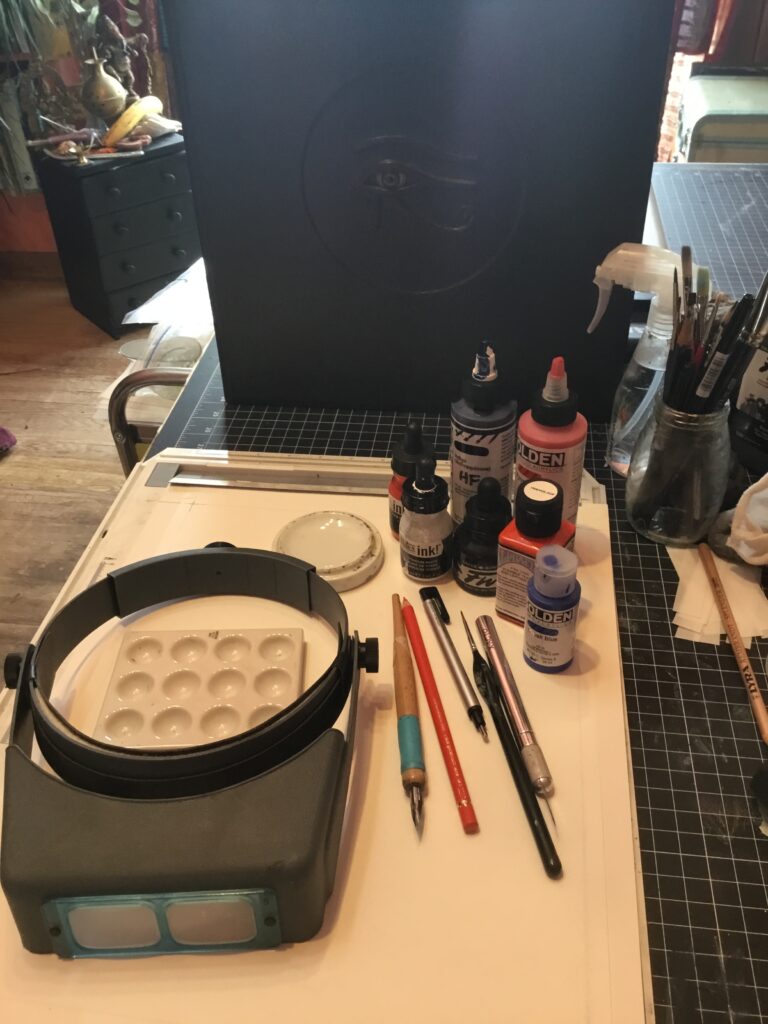
- The dorky looking headset – absolute necessity for seeing teeny tiny details with my eyes not being what they used to
- The drafting board is great. I clip the paper in it and it has vertical and horizontal ruler guides built in
- I love the porcelain palettes and use them for every type of paint. I have a ton of the round ones shown that are stackable which is great! And the one with 12 teeny wells I found in an antique store years ago. It’s great for using the liquid ink as you only need small amounts at a time
- The nib pen is a Tachi nib holder and a Nikko Japanese G nib. I also use a smaller crow quill nib sometimes. Those two were what I used to do all the inked line art for the new deck
- The black ink lines were all done in FW ink
- I like the little TomBow eraser for erasing fine lines. If I get some colored pencil on some of the black ink lines where I don’t want it, it can carefully remove it
- The Exacto knife is good for scratching details or carefully scratching off a stray droplet of dried ink or removing some colored pencil buildup
- The brush is one I’ve been using for every single card. I’m weird in that I use that same tiny brush for everything – tiny details OR huge areas of flat color. I tend to pick a brush and use it til its worn to nothing. I have TONS of brushes – some of them quite expensive – but so far I’ve just been doing everything with that brush. I’m not even sure what it is as it came free with some paints I bought, and just has the companies name on it, so it’s swag. I wish I could buy more.
- For the colors, I use a lot of acrylic ink. Mostly I use the Liquitex “Ink!” brand, but I also use FW ink, and Dr Martin’s Bombay ink.
- For acrylic paint I use a lot of Golden products: the Fluid acrylics, the Matte acrylics, and the High Flow acrylics
- I also use Alpha6 fluid acrylic paints and love them. The ones I’ve been using are formulated for painting on cloth and leather as they are flexible, but I also use them on the mylar (that’s what all these cards are painted on
- I’m using colored pencils too, mostly an oil based pencil by Faber Castell called PolyChromos. Love them! But I also have the PrismaColors wax based which work really well on the mylar too
- Once in a while I use pastel pencils by Stabilo, for some things, or a white charcoal pencil by General
- As the cards progress who knows, I might also use gouache or acrylic gouache, panpastel, ink pencils, or even oils – whatever works I’ll use!
And now, some of the art. I guess since this is the first post showing the completed cards it is fitting that it will be of the Aces. The Majors and Minors of this deck are based on the 777 descriptions, but the Aces and Courts are based on the Golden Dawn descriptions from Book T or Liber Theta.
The Ace of Wands – that fire effect was super fun to paint, using a “wet-in-wet” technique and transparent paints.
Golden Dawn Traditional Description: “A White Radiating Angelic Hand, issuing from clouds and grasp-
ing a heavy club, which has three branches in the colors, and with the sigils, of the scales. The
right- and left-hand branches end, respectively, in three flames, and the center one in four flames;
thus yielding 10, the number of the Sephiroth. Twenty-two leaping flames, or Yods, surround it,
answering to the 22 Paths; of these, three fall below the right branch for Aleph, Mem, and Shin;
seven above the central branch for the double letters; and between it and that on the right, 12 (six
above and six below) about the left-hand branch. The whole is a great and flaming torch.”
In all the Aces, as in the Thoth deck, I’ve chosen not to depict the “White Radiating Angelic Hand” holding the elemental implement. Also, while I otherwise followed the description, I’ve never really been happy with the way this card has been depicted in other Golden Dawn based decks, finding that most depictions show the three branches with ten flames looking way too much like some strangely shaped chicken-foot bouquet with toes ringed in psychedelic colors!
Someone asked to show sketches or even failed sketches as part of the process. Here is something that is kind of both.
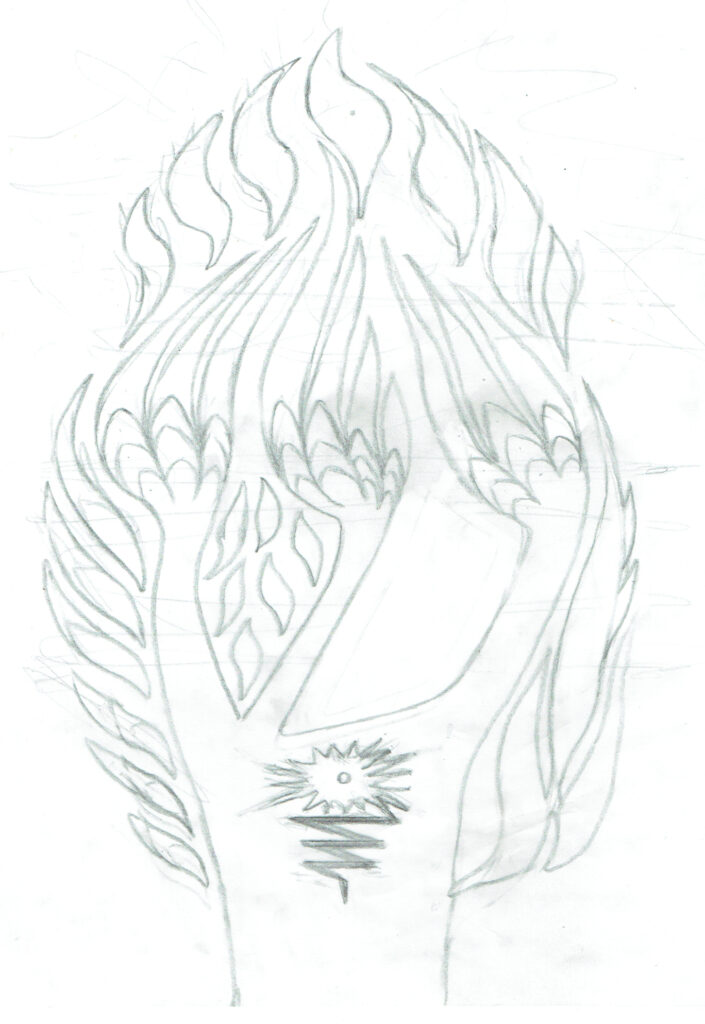
Each of the Aces has an element that ties it to its related elemental Major, but I guess that won’t be obvious until you see them together. In the Ace of Wands, it’s the being at the wands base making the magical gesture for fire, as seen in the Aeon/Judgement card.
Here is a little excerpt from the guidebook saying what each element of the picture is and why it was chosen. The guidebook will also have the card meanings as used in a reading, but I’m just placing the section on the symbolism here.
The Symbolism of the drawing: (excerpted from the forthcoming guidebook © M.M. Meleen)
Here the heavy club with three branches has become a torch with the branches forming the three segments of the letter Shin, associated with The Aeon, elemental Major of Fire. As in the description, the flames are colored in the Golden Dawn color scales, each appropriate for what it represents. The central branch ending in four flames is colored with the King Scale colors of the sephiroth of the Middle Pillar of the Tree of Life: the uppermost white for Kether, followed by clear pink rose for Tiphareth, indigo for Yesod, and yellow for Malkuth.
The three flames that top the left branch are crimson, orange, and violet purple for Binah, Geburah, and Hod. The flames of the right branch are pure soft blue for Chokmah, deep violet for Chesed, and amber for Netzach. All have white bases for Kether.
The description references “yod-shaped flames” as the Ace of Wands corresponds to the first letter of the name YHVH, the yod. Yod, meaning hand, is the divine hand of creation. It’s the primal male force, looking very much like a spermatozoon. The simple flame of Yod is the basis of creation for all of the other Hebrew letters. It is said that the first sephira, Kether, emerges from the tip of the Yod.
The 22 yod-shaped flames represent the paths, or Major Arcana. The three largest on the right are in the three primary colors, and stand in for the three classical elements, or the Hebrew “mother letters” Aleph (air), Mem (water), and Shin (fire). Of these, Shin is the largest, for the elemental fire of the Wands suit.
The seven flames above the wand represent the seven classical planets, or the seven “double letters”, and are appropriately colored in their seven prismatic colors. Green as the central of the seven flames is appropriate, for the glyph of Venus encompasses the Tree of Life itself. The 12 yod-flames around the left branch expand these colors, adding secondary colors, to represent the 12 zodiacal signs or “single letters”.
On the body of the torch, the white symbol is the sigil of Kether. All of the Aces correspond to Kether but none more than the Ace of Wands, the first of the first. The red glyph is the sigil of fire and archangel Michael. The green ankh is the Egyptian symbol for growth, and life. Below the symbols, the spirit emerging from the base of the wand is the figure from the Aeon card (elemental trump of Fire), making the upright triangle symbol of fire upon his brow.
The Ace of Wands, as the first of the Minor Arcana, tells the story of creation, and the emerging spark of life that creates the lightning strike. This is the lightning path of the flaming sword that traces the ten sephiroth of the Tree of Life as the world was created. This lightning spontaneously erupts from out of the three veils that precede creation: Ain (Nothing), Ain Soph (Limitlessness or Infinity), and Ain Soph Aur (Endless Light). From the deep void of “Nothing” comes a fade from dark to light representing the “Infinity”, and then the white of “Endless Light” comes forth in splendor. This forms the white sun of Kether, the first sephira. The color of Kether in the King Scale is only described as “Brilliance”. In both the Queen and Prince Scales, the color is “White Brilliance”. In the Princess Scale, the color becomes “White, flecked gold”, and this is what we see in the emerging rays.
An explosion of 78 red tetrahedrons follow, for the complete 78 cards of the tarot. The tetrahedron is the platonic solid for the Fire element, and the platonic solids are the building blocks of all creation. The tetrahedron is the has the simplest structure and the smallest volume of all the platonic solids. As the simplest structure with both an “inside” and an “outside” and the only with the same number of vertices as faces, it is considered the fundamental unit of creation. The “Flower of Life” we are familiar with in its 2D depiction is comprised of 64 tetrahedrons in 3D. The tetrahedron is also associated with the solar plexus chakra, the center from which we draw personal power with which to perform our Will, and manifest and create.
At the bottom of the lightning flash, the Tree of Life ends in Malkuth, the fourfold elements in earthly manifestation. Below them, the black face of a pyramid is rayed with yellow: the color of the Princess Scale of Malkuth, the final stage of materialization.
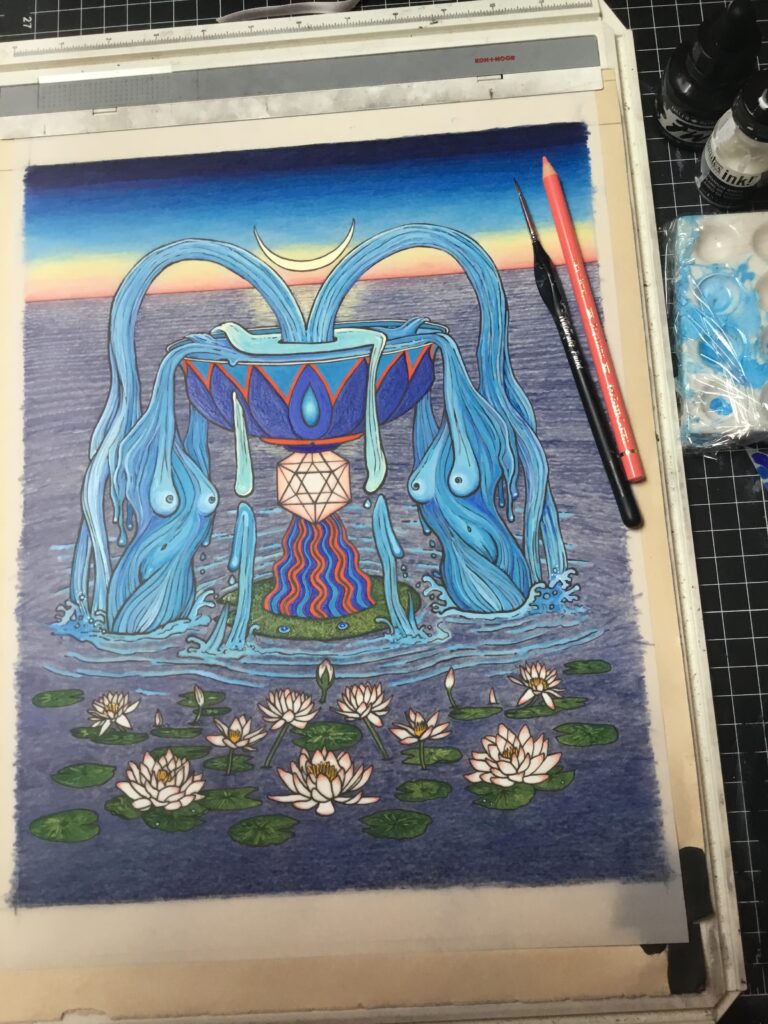
The Ace of Cups Golden Dawn Traditional Description: “A White Radiant Angelic Hand, issuing from clouds, and supporting on its palm a cup, resembling that of the Purifier. From it rises a fountain of clear and glistening water; and sprays falling on all sides into clear calm water below, in which grow lotuses and water-lilies. The great Letter of the Supernal Mother (heh primal) is traced in the spray of the Fountain.”
As mentioned in the traditional description, the great Letter of the Supernal Mother (heh primal of the Tetragrammaton YHVH) is traced in the spray of the Fountain, and glows slightly more illuminated by the moonlight. Heh has the meaning of “window,” which is an opening that lets in illumination. It is a female and receptive energy – the form that receives the force of the Yod that precedes it. If the Ace of Wands is a “solar-phallic force” then the Ace of Cups is a “lunar-yonic form.”
Note that the fountain also forms what appears to be the letter M, which corresponds to the Hebrew letter Mem which means “water” and is associated with the Hanged Man, trump of elemental water. It is the hum of Om, the sacred sound of meditation. The letter M and words derived from it have connections to things of the sea, things of matter, and things maternal. The spray also creates the forms of undines, naiads or water nymph spirit beings associated with elemental water. These in shape are reminiscent of the dryad or Meliae of the ash tree upon which the Hanged Man is suspended.
Ace of Swords Golden Dawn Traditional Description: “A White Radiating Angelic Hand[1], issuing from clouds, and grasping the hilt of a sword, which supports a White Radiant Celestial Crown; from which depend, on the right, the olive branch of Peace and, on the left, the palm branch of suffering. Six Vavs fall
from its point.”
[1] In all the Aces, as in the Thoth deck, I have chosen not to depict the “White Radiating Angelic Hand” holding the elemental implement.
Check out that funky impossible perspective on the white crown!
The sword issues from a bank of clouds of the air element, and as in the traditional description, “supports a White Radiant Celestial Crown; from which depend, on the right, the olive branch of Peace and, on the left, the palm branch of suffering.” Peace and suffering describe the next two cards of the suit, the Two and Three of Swords. They also represent a duality of mind states encompassing the human experience, that Buddhists know well as a teaching about suffering and the cessation of suffering.
White brilliance is the color of the Aces in the Prince Scale. The white crown is a symbol of the first sephira Kether (the Crown) – the source of divinity. The crown is here depicted flared out from a unique and impossible perspective, to show that it is comprised of 22 points. Twenty-two is recognizably the number of Major Arcana – and while the Fool, the Major Arcana elementally associated with Air is numbered as Atu zero, it is considered the 22nd trump and alternately numbered twenty-two. We see the profile of the Fool engraved on the Damascus steel blade. The hilt of the sword is winged, for the Air element.
Twenty-two is also the path of the Hebrew letter Lamed, the Justice or Adjustment card – the Sword as an instrument of upholding Justice and correcting wrongs. There is also a profound relationship between the Fool card (Air, letter Aleph, the Ox) and the Justice/Adjustment card (Libra/Lamed, the Ox Goad). Lamed/Adjustment is the teacher that shows the Fool the way. The sword is through a large Aleph in its King Scale color of bright pale yellow, and points at Lamed in its King Scale color of emerald green. Together Aleph and Lamed can spell אל (aleph-lamed, AL or El, a name of God) or can spell לא (lamed-aleph, LA, which means “Not”).
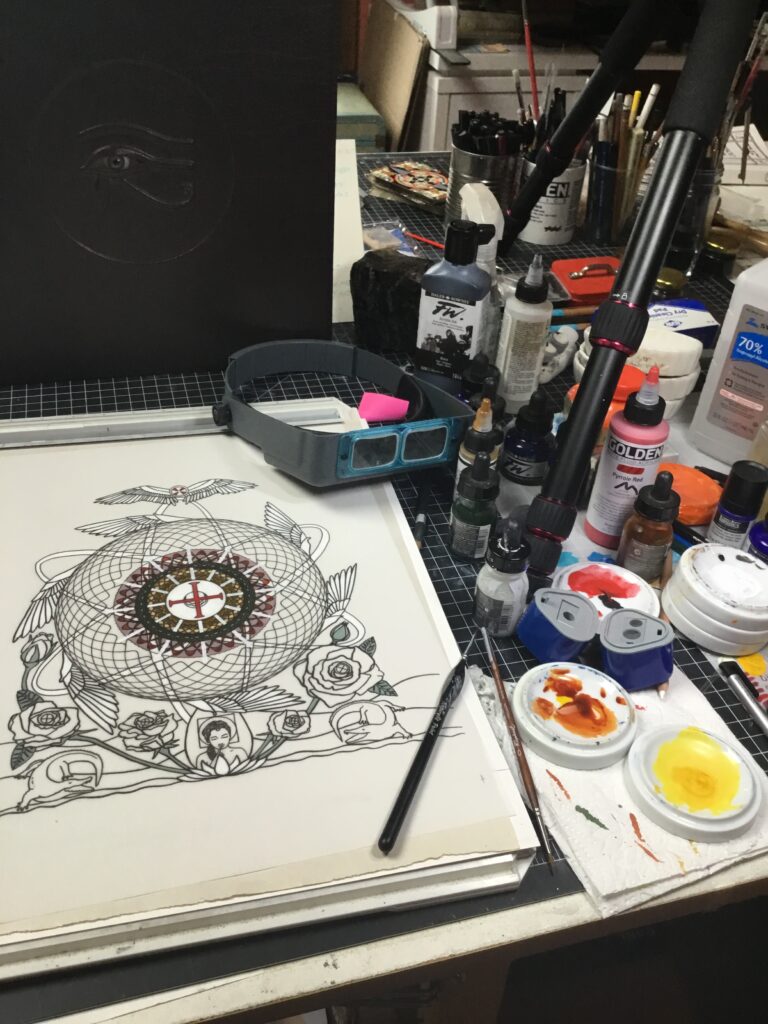
The Ace of Disks in progress, above. Man this one was a challenge to paint. All those tiny details in the mandala of the disk!
Parts of that mandala, in case you were wondering, was created with drafting gears – kind of like Spirograph for adults, if you are old enough to remember the Spirograph toy! It’s actually created by a combination of several different gear designs, and I had to get each to line up precisely with the next, so that all the inner and outer rings align, so they all had to match mathematically.
Both the inner and outer rings all have 36 petals, all based on maths of 6 and 36. 36 for the number of the zodiacal decans (and the minor arcana) as well as 36 being a solar number for the same reason (the sun’s yearly travel thru the decans) and as 6×6, the magic square of the Sun. The Sun and the Earth pentacle are intimately interconnected.
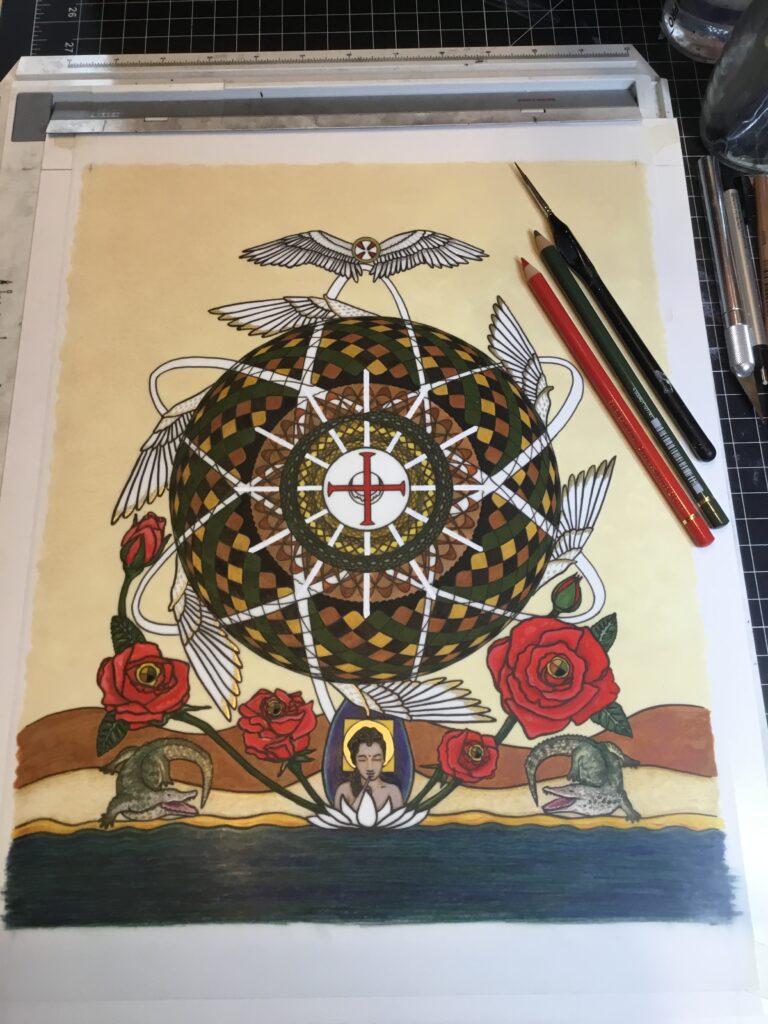
Ace of Disks Traditional Description: “A White Radiant Angelic Hand, holding a rose tree branch,
whereon is a large Disk formed of five concentric circles. The innermost circle is white, charged
with a red Greek cross. From this white center, 12 white rays issue; these terminate at the circumference, making the whole resemble an astrological figure of the heavens. It is surmounted by a small circle, above which is a large white Maltese cross, and with two white wings. Four crosses and two buds are shown. The Hand issues from the clouds as in the other three cases.”
I do wonder about that penultimate sentence: “Four crosses and two buds are shown.” I really wonder if that is a typo – shouldn’t it be four roses and two buds are shown? I checked and both Book T and Liber Theta say “crosses”. All the other GD decks show four roses and two buds on the Ace of Pentacles, and no crosses. But I found it inspiring, as if you look closely at the four open roses, each has a little Malkuth cross in the heart of the rose’s center. The flowering of the four worlds.
all images and text © 2020-2023 M.M. Meleen
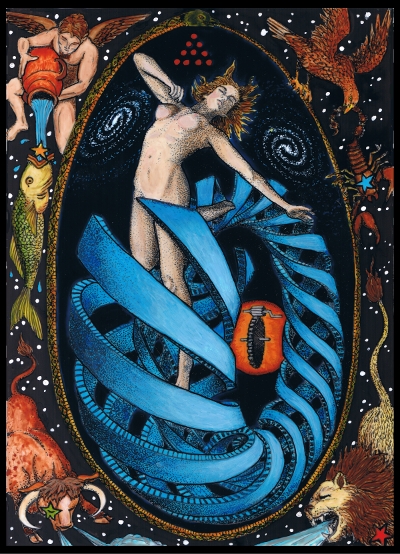
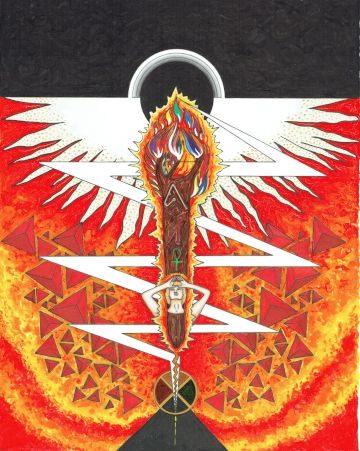
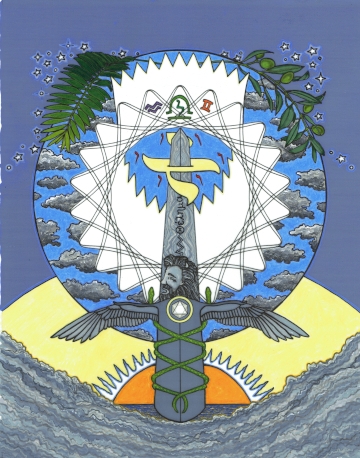
Mel,
When Tabula Mundi came out I purchased a few editions. I am the proud owner of deck 7/495 of the wooden box edition, as well as decks 109 and 110 out of 418 of the Nox et Lux, and I own printed scans of the majors signed by you as well.
Not sure if this was intentional or not, but I thought I saw that 495 number in connection with some astrology work I’ve been doing lately. Indeed, this is the number of lunations in 5 octaeterides. If you weren’t aware, the octaeteris is a lunar cycle whereby every 99 lunations the same phase occurs near the same point in the sky at near the same date. It’s a period of 8 years plus 1.5 days on average. You may have heard of the Metonic cycle, which is more exact but takes 235 lunations (19 tropical years exactly, plus about 2 hours) to complete. Well the octaeteris is a shorter, 8-year cycle, but it has good synchronization with the 8-year phase cycle of Venus. And 5 of those are exactly 495 lunations. Cheers.
Thank You so much for your commitment, patience and ever impressive Talent. i have followed all your work since the early Rosetta days, this new project – WOW!
XCIII
Thanks Will! You have been around for a long time, thank you! – it’s been a long strange trip! 🙂
Thank you M.M.Meleen for this amazing creations! Looking forward to see it all 😀 🙏
Thank you Karla! More coming soon 🙂
😌
What is the new deck? Sorry if I’m late to this.
Hi Cara – It’s a talismanic tarot based on the 777 descriptions. I haven’t named it publicly yet.
This is looking great! You are someone with amazing attention to detail and dedicated all the way.
Hey Jeffrey – thanks so much!
These Aces are simply spectacular! I can’t wait to see the entire deck – I’m drooling and my palms are getting sweaty already just from this little foretaste. All of your work is remarkable, and I feel a thematic progression from one to the next as well. Thank you for bringing this into being!
Thank you Jon!
I agree with Jallez! I always look forward to seeing your posts in my email. Your work is exquisite and I love seeing the new forms your work takes from one deck to the next. Thank you for sharing your work and truly appreciate the effort you put into it! AI decks are fine, but I feel that if you create it with your own hand, you are giving us a bit of your magic to put with our own. Thank you again!
Thanks Marcia!
This is simply spectacular. Wonderful work, as always. Can’t wait to see the rest of this very promising deck !
Thank you!!
I nearly cried as I recognized the dedication, the time and focus involved…as if one could walk in your garden of art and emerge transformed. Well, something akin to that. Words fail.
It does take a lot of time! But it keeps me out of trouble 🙂
Thank you for taking the time to comment!